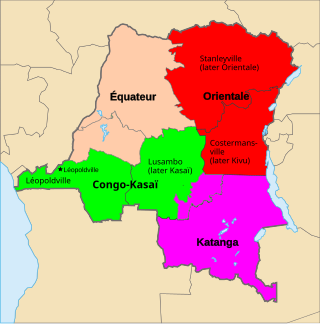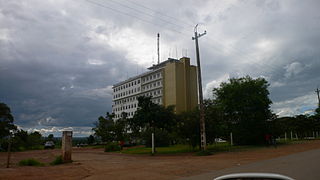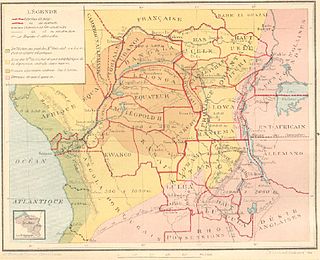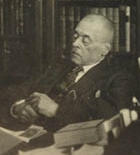| |||||
| Decades: | |||||
|---|---|---|---|---|---|
The following lists events that happened during 1913 in the Belgian Congo .
| |||||
| Decades: | |||||
|---|---|---|---|---|---|
The following lists events that happened during 1913 in the Belgian Congo .
| Date | Event |
|---|---|
| Orientale Province is formed from the District of Orientale Province, Haut-Uélé, Bas-Uélé and Aruwimi. The new province contains the districts of Bas-Uele, Haut-Uele, Ituri, Stanleyville, Aruwimi, Maniema, Lowa and Kivu. | |
| Forminière (Société internationale forestière et minière du Congo) begins diamond mining in Kasai. [1] | |
| The Union Minière du Haut-Katanga starts to work the open pit Luishia Mine deposit of copper and cobalt. [2] | |
| 7 November | Justin Malfeyt is appointed deputy governor-general of Orientale Province. [3] |

Katanga was one of the four large provinces created in the Belgian Congo in 1914. It was one of the eleven provinces of the Democratic Republic of the Congo between 1966 and 2015, when it was split into the Tanganyika, Haut-Lomami, Lualaba, and Haut-Katanga provinces. Between 1971 and 1997, its official name was Shaba Province.

Orientale Province is one of the former provinces of the Democratic Republic of the Congo and its predecessors the Congo Free State and the Belgian Congo. It went through a series of boundary changes between 1898 and 2015, when it was divided into smaller units.

Lubumbashi is the second-largest city in the Democratic Republic of the Congo, located in the country's southeasternmost part, along the border with Zambia. The capital and principal city of the Haut-Katanga Province, Lubumbashi is the center of mining in the region, acting as a hub for many of the country's largest mining companies. No definite population figures are available, but the population of the city's urban area is estimated to be around 2,584,000 in 2021.

The University of Lubumbashi, also known by the acronym UNILU, is one of the largest universities in the Democratic Republic of the Congo. It is located in Lubumbashi in Haut-Katanga Province, previously Katanga Province. The campus is located in the northern part of the city, west of the airport.

The Republic of the Congo was a sovereign state in Central Africa, created with the independence of the Belgian Congo in 1960. From 1960 to 1966, the country was also known as Congo-Léopoldville to distinguish it from its northwestern neighbor, which is also called the Republic of the Congo, alternatively known as "Congo-Brazzaville". In 1964, the state's official name was changed to the Democratic Republic of the Congo, but the two countries continued to be distinguished by their capitals; with the renaming of Léopoldville as Kinshasa in 1966, it became also known as Congo-Kinshasa. After Joseph Désiré Mobutu, commander-in-chief of the national army, seized control of the government in 1965, the Democratic Republic of the Congo became the Republic of Zaire in 1971. It would again become the Democratic Republic of the Congo in 1997. The period between 1960 and 1964 is referred to as the First Congolese Republic.
Societé minière de Bakwanga is a diamond mining company based in the Democratic Republic of the Congo. Historically, the company was the largest diamond producer in the world by volume. However, following decades of decline, the company currently produces only a small minority of the DRC's diamonds.

Manono is a town and territory in Tanganyika Province, Democratic Republic of the Congo.
This is a survey of the postage stamps and postal history of the Democratic Republic of the Congo, formerly Zaire and the Belgian Congo.
Copper mining in the Democratic Republic of the Congo mainly takes place in the Copper Belt of the southern Katanga Province of the Democratic Republic of the Congo.

The Kambove mines are a group of active or abandoned copper mines near Kambove in the Democratic Republic of the Congo. They were originally established by the Union Minière du Haut-Katanga under Belgian rule.
The Etoile Mine is an open-pit copper mine on the outskirts of Lubumbashi in Katanga Province of the Democratic Republic of the Congo (DRC). Chemaf owns the license. Chemaf is 95% owned by Shalina Resources and 5% by the DRC government.

The Luiswishi mine is an open cut copper and cobalt mine in Katanga Province of the Democratic Republic of the Congo (DRC).

Thierry Michel is a Belgian film director, mostly making social and political documentaries. His office and company Les films de la passerelle is located in Liège, where he works with the producer Christine Pireaux. Over a twenty-year period he has made a series of documentaries on different aspects of Zaire . Taken together his films provide a unique overview of the social, economic and political life of the country.

The Société internationale forestière et minière du Congo, known as Forminière, was a lumber and mining company in the Belgian Congo. Founded by Jean Jadot in 1906, the company began diamond mining in Kasai in 1913. At its height, Forminière was involved in gold and silver mining, cotton, palm and rubber cultivation, farming, sawmilling and even owned shops. The Belgian colonial state co-owned 50 percent of the company's capital, the rest being held largely by American shareholders.
The following is a timeline of the history of the city of Lubumbashi, Democratic Republic of the Congo.
Justin-Prudent-François-Marie Malfeyt was a Belgian soldier, engineer and administrator. He served in various senior administrative positions in the Belgian Congo, including command of the Orientale and Katanga provinces.

Congo-Kasaï was one of the four large provinces of the Belgian Congo defined in 1914. It was formally established in 1919, and in 1933 was divided into the new provinces of Léopoldville and Lusambo.

Alexis Félicien Bertrand was a soldier and senior colonial administrator. He left the colonial service in 1918 after falling out with his superiors, and later became known as a vocal critic of the brutal treatment of the Congolese workers.
The following lists events that happened during 1906 in the Congo Free State.